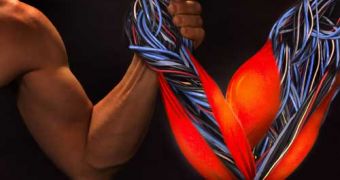Remember Will Smith, in the iRobot movie? One of his arms was actually a robotic prosthesis, but it could mimic the human arm to such an extent, that it was able to go unnoticed through the first half of the movie. Only its superhuman abilities had finally blown its "cover", so to say.
A prosthesis is an artificial extension that replaces a missing body part. Prostheses are applications typically used to replace parts lost by injury (traumatic) or missing from birth (congenital) or to supplement defective body parts.
A new prototype limb prosthesis has been developed for the Defense Advanced Research Projects Agency Revolutionizing Prosthetics Program (DARPA), by the Johns Hopkins University Applied Physics Laboratory.
It's the first fully integrated prosthetic arm that can be controlled naturally and provide sensory feedback and allows for eight degrees of freedom, a level of control far beyond the current state of the art for prosthetic limbs. The complete limb system also includes a virtual environment used for patient training, clinical configuration and to record limb movements and control signals during clinical investigations.
Named Proto 1, the prototype is the latest development of a long-lasting tradition of replacing missing limbs with manmade ones. In fact, an artificial limb is mythologically referred to in the Rigveda, as the "iron leg" given to Vishpala by the Ashvins. The first specimen discovered archaeologically was found in a tomb in Capua, Italy, dating to 300 BC and was made of copper and wood. Armorers in the 15th and 16th centuries made artificial limbs out of iron for soldiers who lost limbs. Over the next several centuries, craftsmen began to develop artificial limbs from wood instead of metal because of the lighter weight of the material.
The advanced degree of natural control and integrated sensory feedback demonstrated with Proto 1 are enabled by Targeted Muscle Reinnervation, a technique pioneered by Dr. Todd Kuiken at RIC that involves the transfer of residual nerves from an amputated limb to unused muscle regions in appropriate proximity to the injury. In this case, the nerves were transferred to the pectoral area of the patient's chest. This procedure provides for a more intuitive use of a prosthetic arm and allows for the natural sensation of grip strength and touch.
The team members are already hard at work on a second prototype, expected to be unveiled in late summer. It will have more than 25 degrees of freedom and the strength and speed of movement approaching the capabilities of the human limb, combined with more than 80 individual sensory elements for feedback of touch, temperature and limb position.
This is yet another technological advance that may further dim the boundary between human and machine.

 14 DAY TRIAL //
14 DAY TRIAL //